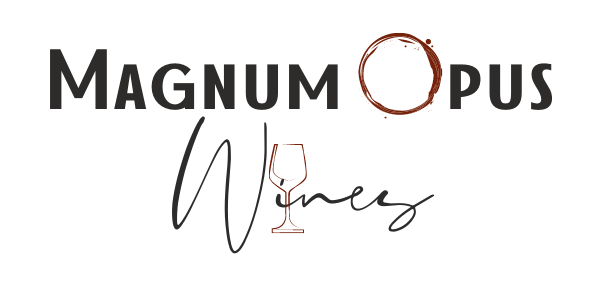LEARN HOW TO TASTE WINE LIKE A PRO FROM OUR IN-HOUSE SOMMELIER!
May 09,2022 | Guillaume Pace
Part #2 The Nose.
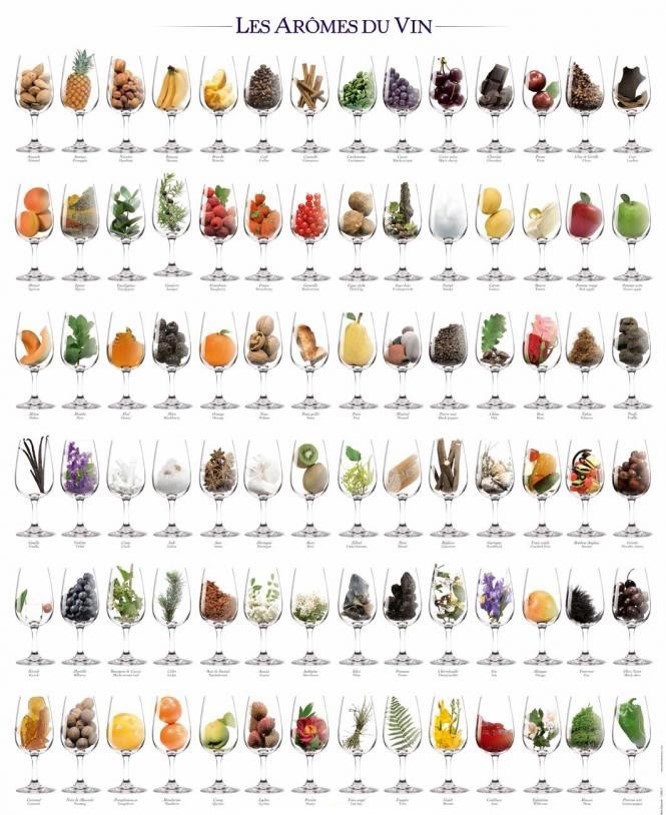
First of all, open a bottle, pour a little bit of wine in a glass, enjoy its sight (see previous article) and take a whiff. The very first nose, before any aeration, allows you to have a precise idea of the state of the wine. Especially if it has spent several years in a bottle. Some subtle aromatics can be overwhelmed by more dominant aromatics that arise after swirling.
Unfortunately, in some cases, you may find out that the wine is faulty, it could smell like mould because of cork taint (TCA), nail-polish or vinegar (acetobacter), have reduced notes like rubber or burnt match (mercaptans), or perhaps it is already oxidised with zero aromas (taste of light) or unpleasant ones (cooked vegetables), or be contaminated by a genus of yeasts that smell like barnyard (brettanomyces).
When it’s just a whiff, decanting or swirling the wine in your glass might allow these notes to “blow off,” and there might be a really beautiful wine underneath those notes. If there’s more than a whiff and those notes won’t go away, put back the cork in place, keep the bottle aside and ask for an exchange!
Fortunately, 97% of the time, the first nose is pleasant, think of fruity, floral, herbal, earthy, oaky, or spicy aromas, but the wine may be a bit shy or introvert, so now you can swirl the glass to increase available surface area, and take advantage of the oxygenation to magnify all the perfume, all the volatile aromatic compounds will fill the cup of the glass.
Get your nose inside the glass, and give a series of short, quick sniffs to maximize the range of aromatics being detected. Your olfactory sensory neurons, which are located high inside the nose, connected directly to the brain, will send electric signal that your brain will recombine to create mental pictures, familiar images, memories and emotions.
There are several hundred volatile aromatic compounds in a glass of wine (natural phenols and polyphenols, esters, terpenes, thiols…) and the wide array of flavors sensed by the olfactory bulb and transmitted to the brain can be overwhelming at first. Let’s proceed methodically to analyze it.
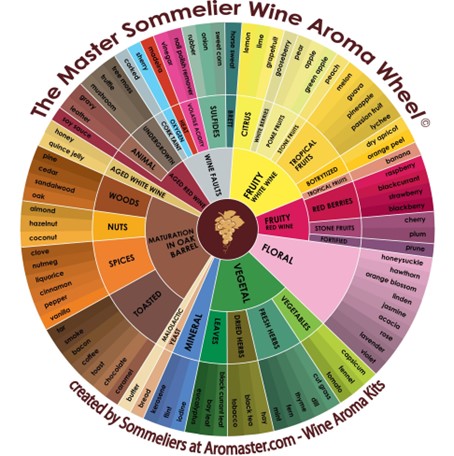
In the wine world, we usually divide the aromas into 3 groups:
1) Primary notes are those specific to the grape variety itself and are most readily demonstrated in a varietal wine, such as lime and petroleum in Riesling (zingerone and TDN), rose and lychee in Gewürztraminer (geraniol), gooseberry in Sauvignon Blanc (pyrazine), yellow peach in Viognier, apple in Chenin Blanc (ethyl butyrate and ethyl acetate) or black currant in Cabernet Sauvignon (methyl anthranilate), plum in Merlot (thiols), Strawberry in Grenache (norisoprenoids), Cherry in Pinot Noir (damascenone), Liquorice in Syrah (rotundone), etc.
Usually grapes growing in cool climates will have more citrusy aromas in white wines (lime, lemon, grapefruit) and red berries aromas in red wines (raspberry, red currant, red cherry), whereas grapes growing in warm climates will have more tropical fruits flavors in white (pineapple, passion fruit, banana) and black berries aromas in reds (black cherries, black currant, blueberries...).
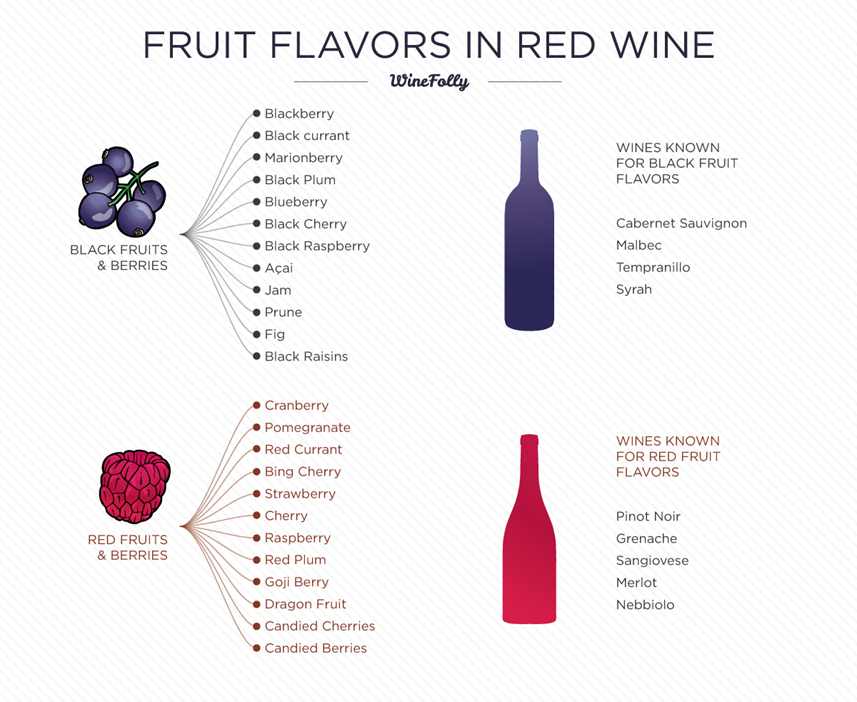
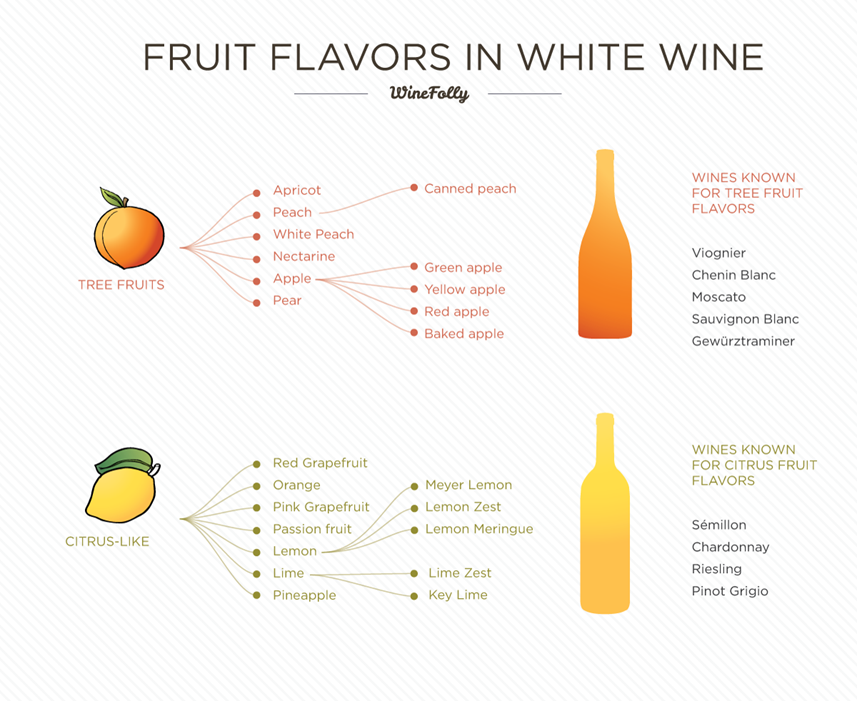
A blend will create even more complex aromas with multiple layers like in Bordeaux (Merlot, Cabernet Sauvignon, Cabernet Franc, Petit Verdot) or the Rhone Valley (Grenache, Syrah, Mourvedre, Cinsaut, Carignan...).
2) Secondary aromas are those derived from the alcoholic and malo-lactic fermentation. Take grape juice, it’s sweet and not particularly complex, nothing at all like wine. Much of the wine’s flavors mentioned above actually come from the action of yeasts (saccharomyces cerevisiae) and where malolactic fermentation takes place, bacteria (oenoccocus oeni). As these organisms grow in the must, they take up a range of nutrients from the grapes, with sugar as the basic energy source, and produce a wide array of chemicals, ethanol and higher alcohols, fatty acids, carbon dioxyde... and release all the precursor compounds that were bound in the grapes skin and flesh.
In addition, yeasts die and release chemicals into the developing wine (autolysis), as well as creating the lees—dead yeast cells at the bottom of the fermenting vessel—that are able to interact with the wine and alter its composition. Particularly important process in Champagne. Batonnage is the process of stirring the fine lees remaining in the barrel of unfinished wine to give it more complexity.
Malo-Lactic fermentation (MLF) basically converts harsh malic acid into the softer lactic acid. The byproduct creates another ester known as diacetyl, which many of us perceive as butter. Chardonnay is naturally high in malic acid and most winemakers trigger MLF to smoothen acidity and create those creamy, buttery notes. Most red wines also undergo MLF as it stabilizes the wine and combines well with oak aging flavours.
3) Tertiary aromas (aka Bouquet) are those that develop through either bottle or oak aging. To keep it simple, each oak forest (French, American, Slovenian...) has its own set of flavour constituents (lactones, furans) that it can impart into the wine and bring aromas of vanilla, clove, hazelnut, coconut... depending on oak species, seasoning and age (oak has more or less tight fibers and harsh tannins). The concentration of guaiacol (aromas of cedar, dark chocolate, tobacco and grilled toast) in wine, originating from oak, is dependent on the degree of barrel toasting (light, medium, heavy), oak surface area (small barrel or very large casks); as well as winemakers decision to use a mix of new and old barrels, and for how long. Experimentation is endless!
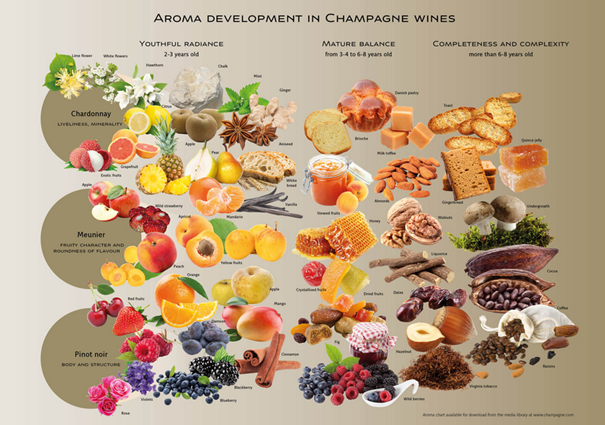
Once bottled, all the wine elements, acidity, alcohol, residual sugar, and tannins are constantly changing, the wine undergoes an evolution and go through phases, usually the nose is quite fresh and fruity in its infancy, but lack complexity, before to find its balance and harmony to reach its peak and eventually it will collapse, oxidised and turn to vinegar...
Each wine, depending on the appellation, the vintage, the involvement of the winemaker in the vineyards, and the storage conditions, does not evolve at the same speed. 2-3 years for some wine is enough and a couple decades is necessary for others. The fresh fruity aromas become more complex, concentrated, and you can expect, honey, dried apricot, baked apple, nutty and rancio aromas in whites, dried fig, jam, undergrowth and truffle, chicory, leather in reds. Some people may say it is an acquired taste, like blue cheese, mustard or durian!
We hope that you enjoyed the reading and learn a thing or two about wine aromas.
There is one more article in this series, Part #3 The Palate. Cheers!
Image credits: Wine Folly, Guild Somm, Aromaster, Champagne.com glassofbubbly.com
